Last time, we talked about how, in the years leading up to World War I, the US Navy developed an array of auxiliary ships designed to support the fleet in the absence of permanent bases. Most prominent among these were the oilers, some of which were used to refuel ships at sea. During the 1920s, as the plans for the war against Japan developed, it became increasingly obvious that the USN would need the ability to reliably refuel ships at sea to carry it off. While the latest destroyers were longer-ranged than the ships Maumee had refueled in the mid-Atlantic, their range was still insufficient for the broad Pacific. As a result, the alongside method of refueling was developed and perfected, to the point that it had become almost routine for the smaller craft. In addition to the oilers, battleships and carriers were also equipped to refuel their escorts.
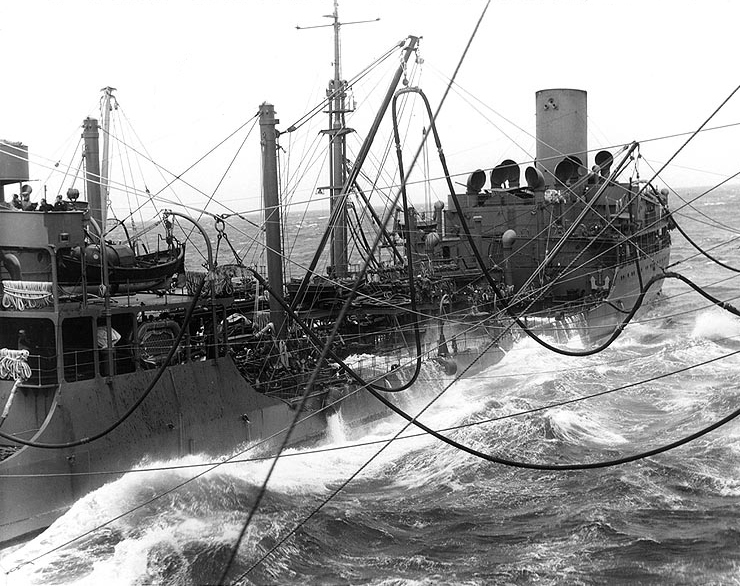
Sabine refueling Enterprise during the Doolittle Raid
But the destroyers were not the only ships with worryingly short legs. The pre-turboelectric battleships had inefficient engines, and a method of refueling them at sea was desired. However, the alongside method was considered far too dangerous for use with any ship larger than a destroyer. Instead, trials were made of refueling over the stern. This removed the threat of small helm errors causing disaster, but turned out to have intractable problems of its own. The fueled ship had to be far astern, which limited flow rate and required inordinate pumping power.1 Special equipment was required to keep the lines supporting the hose under tension. If the hose sagged into the sea, the oil would cool and thicken, interrupting the refueling.2 Ultimately, the problem was solved by refitting the battleships in question with more efficient geared powerplants, and the matter of refueling big ships rested for the next decade.
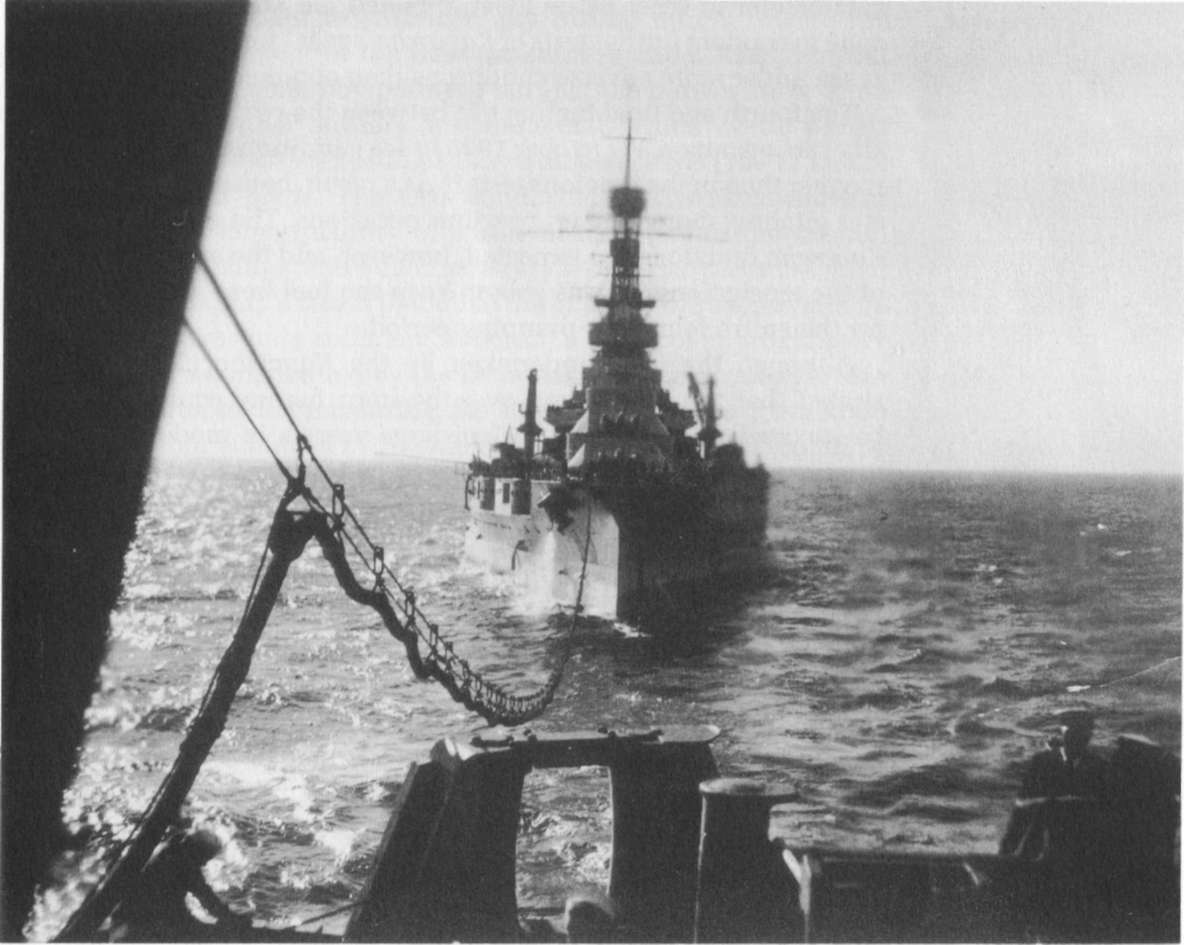
Arizona refueling astern from the oiler Kanawha
In the late 30s, carrier operations made it increasingly apparent that the inability to refuel bigger ships at sea would be a serious hindrance in case of war. During the Fleet Problems, carriers routinely burned as much as 10% of their oil each day. Finally, in the spring of 1939, trials were made with larger vessels using the alongside method under the command of now-Rear Admiral Nimitz.3 They were successful, and the fleet’s few oilers were soon being used extensively for development work.

Cimarron off Norfolk, 1942
In the late 30s, for the first time since WWI, the Navy began to buy oilers. They sought ships capable of keeping up with the fleet at cruising speed, which meant a speed of 16.5 kts, as opposed to the 13 kts typical of tankers at the time. The resulting T3 tanker was designed by the Maritime Commission and the first batch was laid down for various oil companies. Three of the first twelve were taken over before delivery as the first units of the Cimarron class, which eventually numbered 35 ships.4 Turning a civilian tanker into a fleet oiler involved extensive work. Not only did gear for refueling at sea need to be added, but also the capability to carry other types of fluids, such as gasoline for planes and boats, diesel for submarines, and even lubricating oil in drums on deck. Radios, boats, and navigation gear needed to be brought up to naval standards. Steaming with the fleet also required a strong suite of AA guns, with Cimarron being fitted with 4 5"/38 guns, 4 twin 40mm Bofors and 4 twin 20mm Oerlikons. The 5"/38s were accompanied by a Mk 37 director, giving her the same medium gun battery as a prewar destroyer.5 The pressures of war meant that the battery was soon reduced to a single 5"/38 and four 3"/50s with a simple director. All of these guns took extra crew. A Cimarron in civilian service had a design crew of only 69, while the same ship in naval service at the end of the war had accommodations for 301.
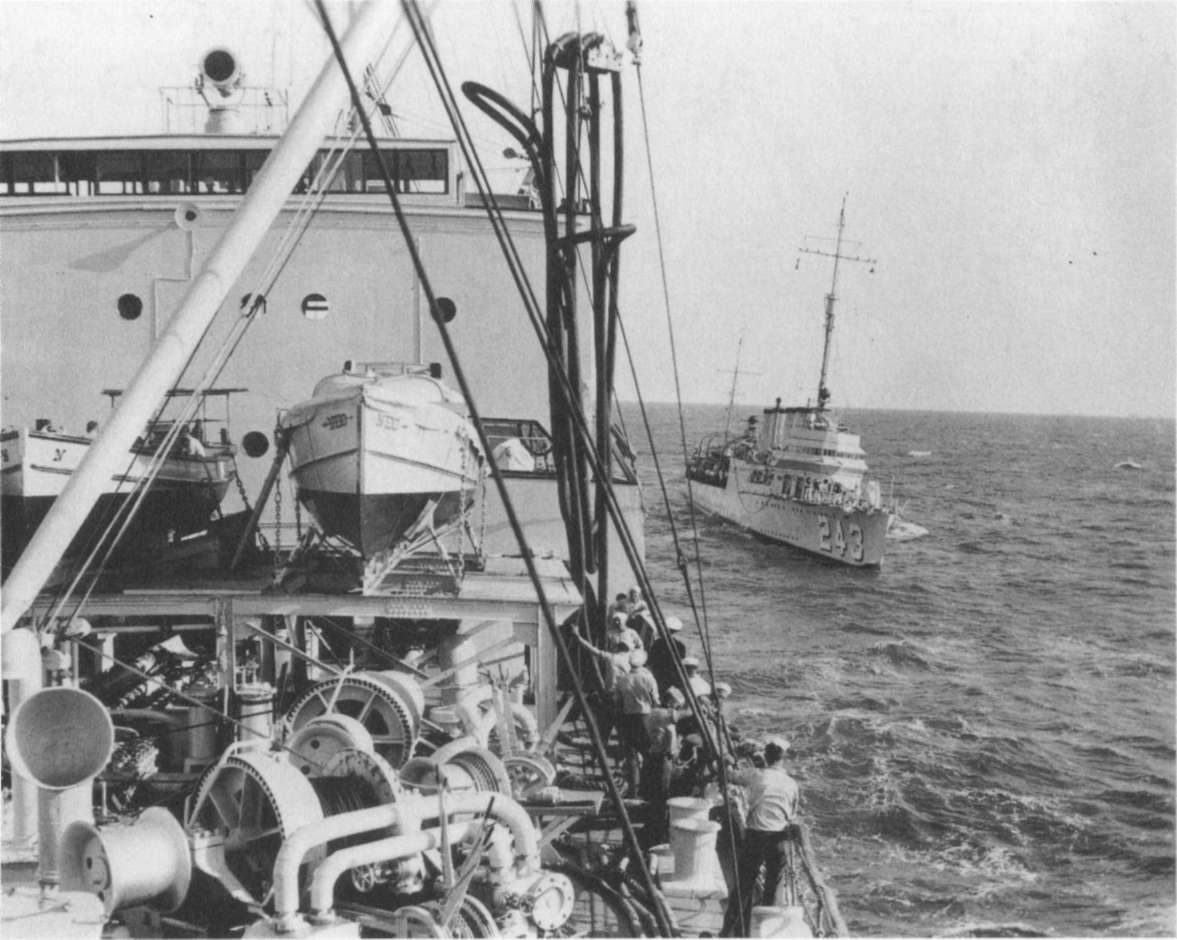
Oiler Neches refueling destroyer Sands
The importance of fast auxiliaries and being able to fuel quickly at sea was demonstrated by the first major operation of the Pacific War, the attempted relief of Wake Island. The task force charged with delivering reinforcements was first slowed by the 12.5 kt speed of the accompanying oiler Neches, then rough seas, inadequate gear6 and inexperienced crews meant it took two days to refuel the escorting destroyers. In the end, this delay sealed Wake's fate.7 Later on, the same techniques were critical to the success of the Doolittle Raid.
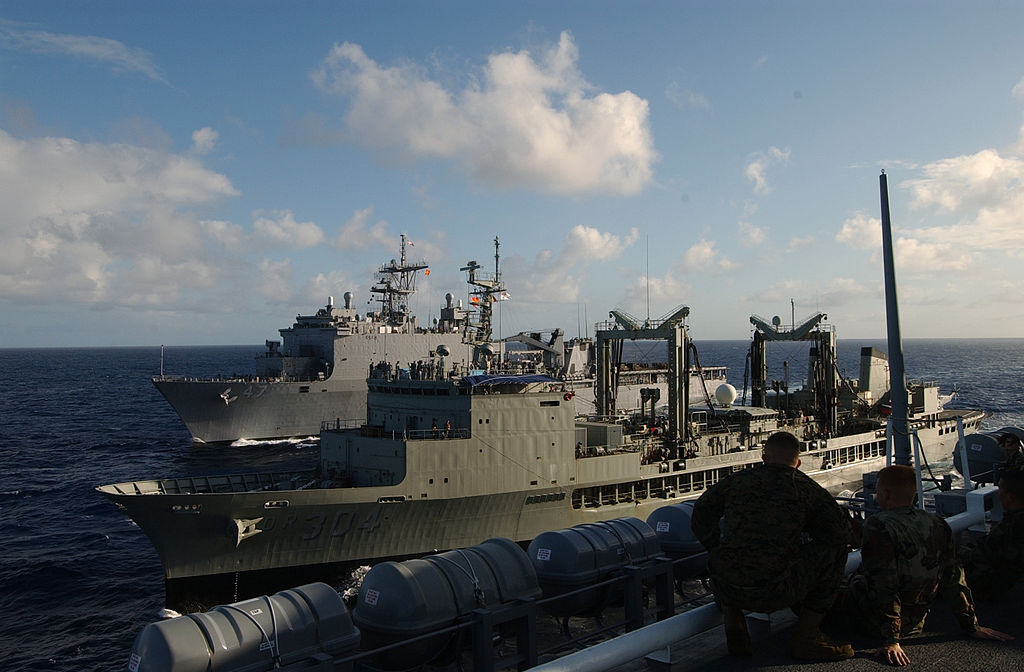
USS Rushmore comes alongside HMAS Success
These sorts of problems were soon overcome, and underway replenishment8 soon became a routine, if still somewhat tricky, operation. Today, it is still practiced in the same basic form, although there have been developments in technique.9 It begins with the oiler on a constant course at a steady speed. The ship to be refueled moves to a station a few hundred yards behind the oiler, and waits for its turn. On a signal, it slowly begins to overtake, staying a hundred feet or so clear of the other ship's side. This process takes 5-10 minutes.
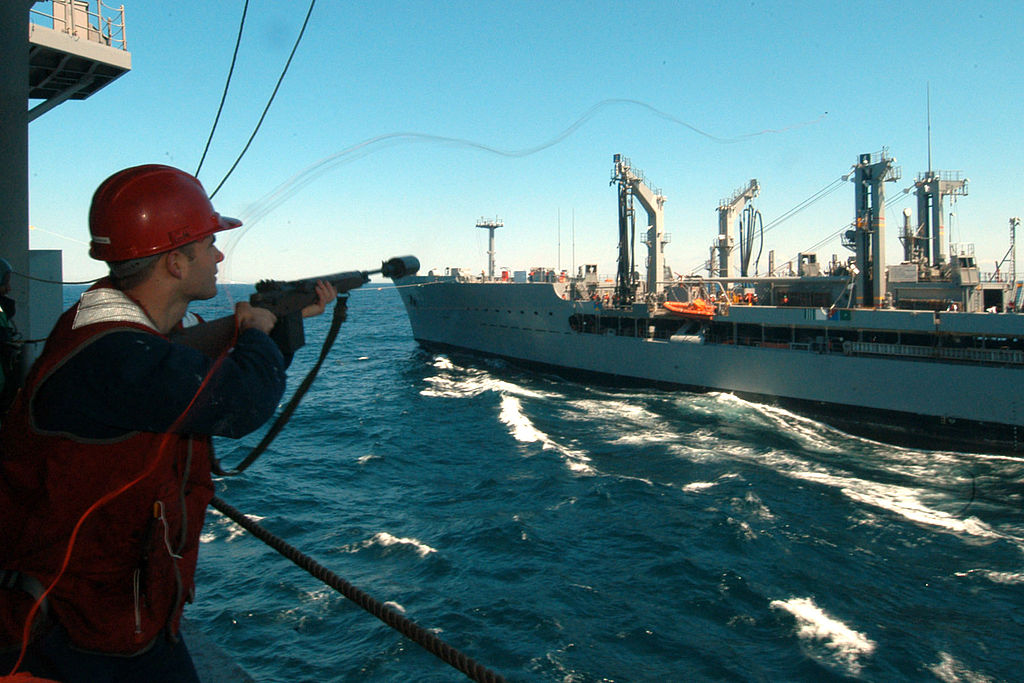
A shotline being fired between ships
The really tricky bit comes as the two ships get close, and the water flowing around their hulls starts to interact. When steaming side-by-side, the effect pulls them together, getting stronger as they get closer. Careful shiphandling, done almost entirely by eye, is required to avoid a collision. At 12 kts, slightly slower than typical replenishment speed, a 1° difference in heading produces a lateral speed of 20 ft/min. The process ends with both ships alongside each other and at the same speed. During the early part of WWII, separation was often 50' or less, while modern equipment allows separation to be around 160'.
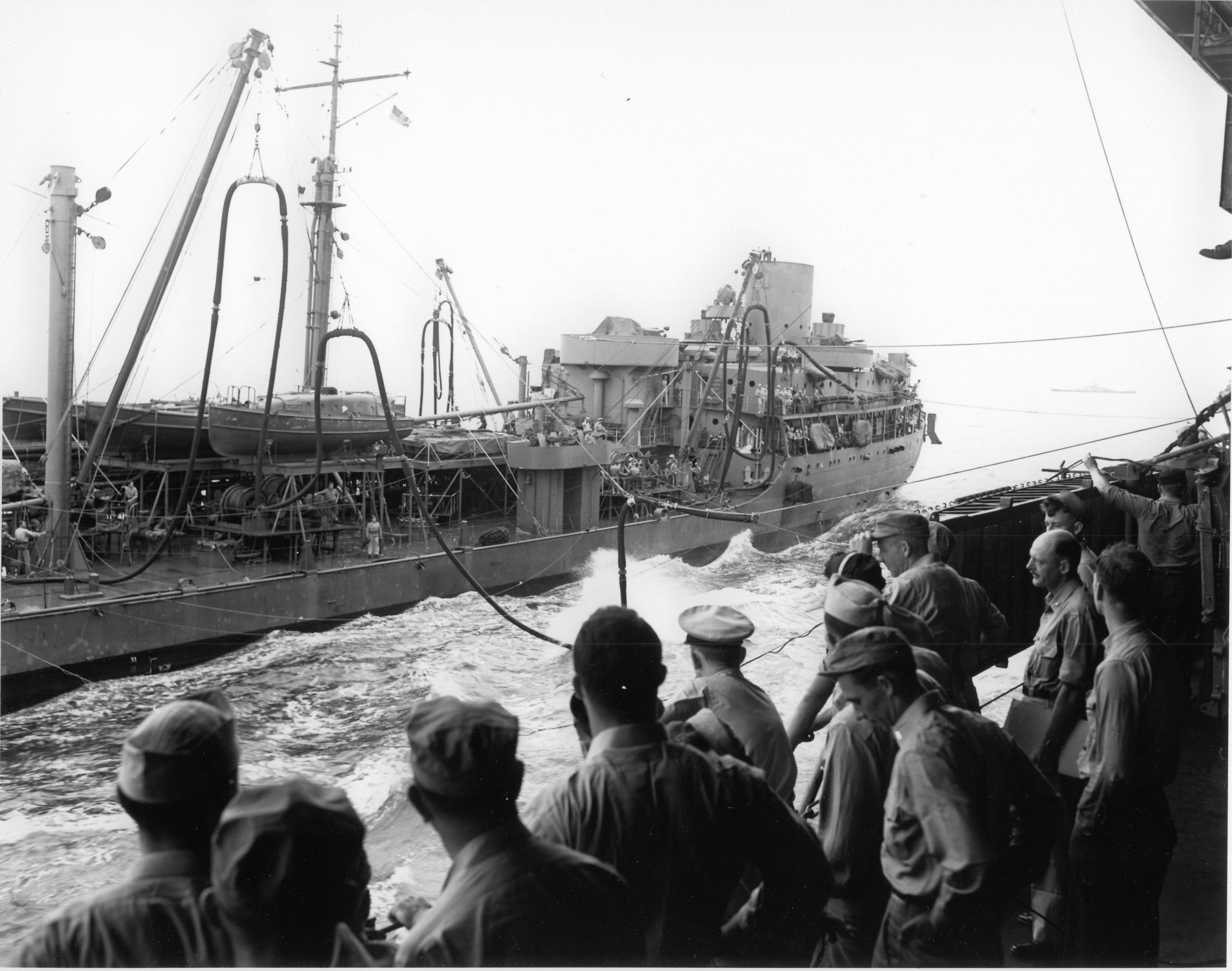
Hoses being pulled across from Cimarron to Enterprise, 1944
The first line, known as the Phone & Distance (P&D) Line, is fired across by a line thrower. This line is marked with flags every 20', making station-keeping much easier, and allows the bridge crews to talk to each other.10 After the P&D line is secured, the shotlines for the replenishment equipment follow. These are light lines, to which heavier messenger lines are attached and hauled over. These in turn allow the even heavier spanwires, which support the hoses, to be hauled across the gap between ships.
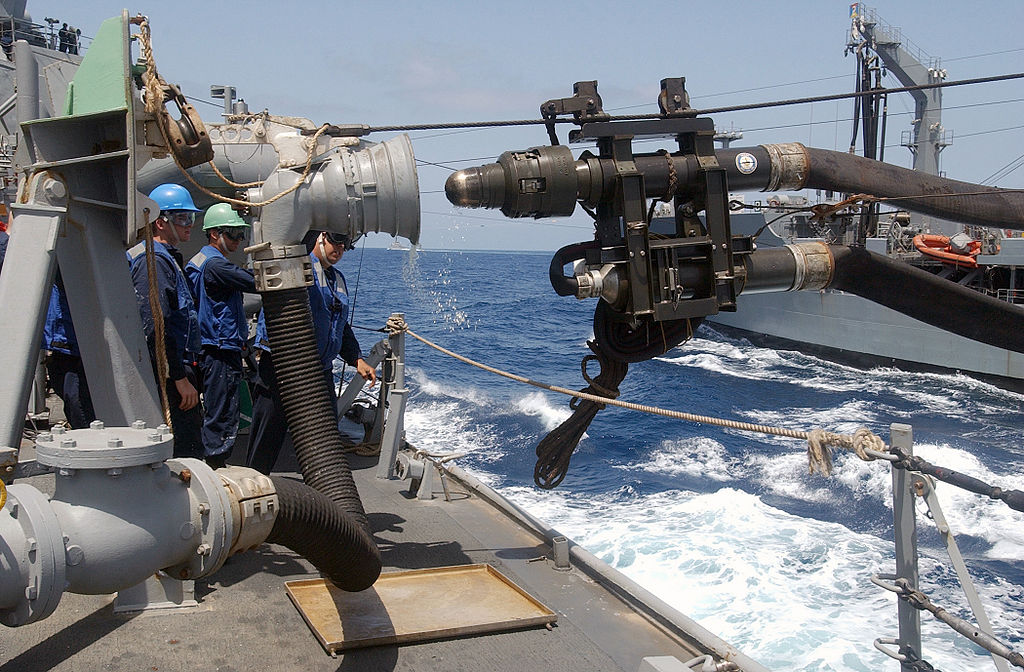
A fuel probe is hooked up
Multiple hoses are often sent across at this point, to allow faster fueling. Elaborate mechanisms onboard the oiler ensure that the spanwire is properly tensioned despite the movement of the two ships. Modern refueling rigs can support a variation of about 40' on each side of the 160' mark, and include automatic disconnects for the hoses if the tension becomes too great. During WWII, men with axes were used instead.
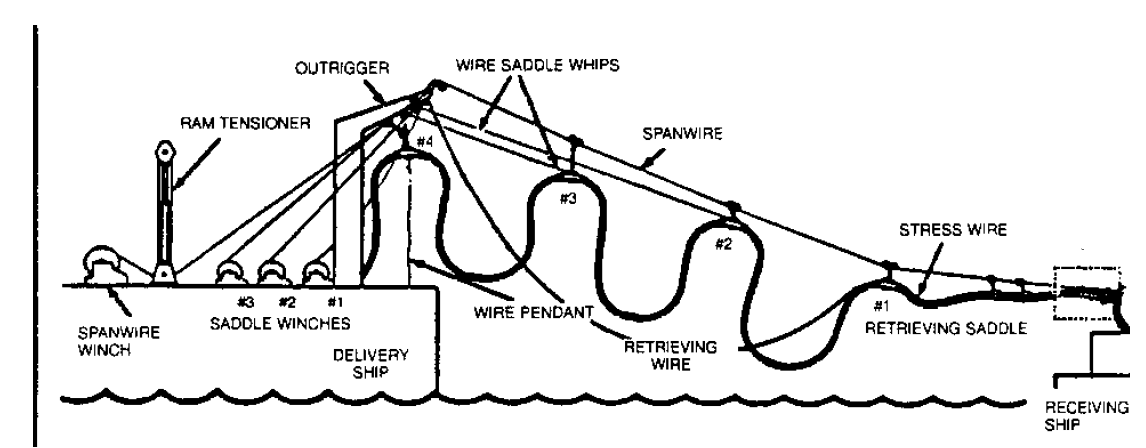
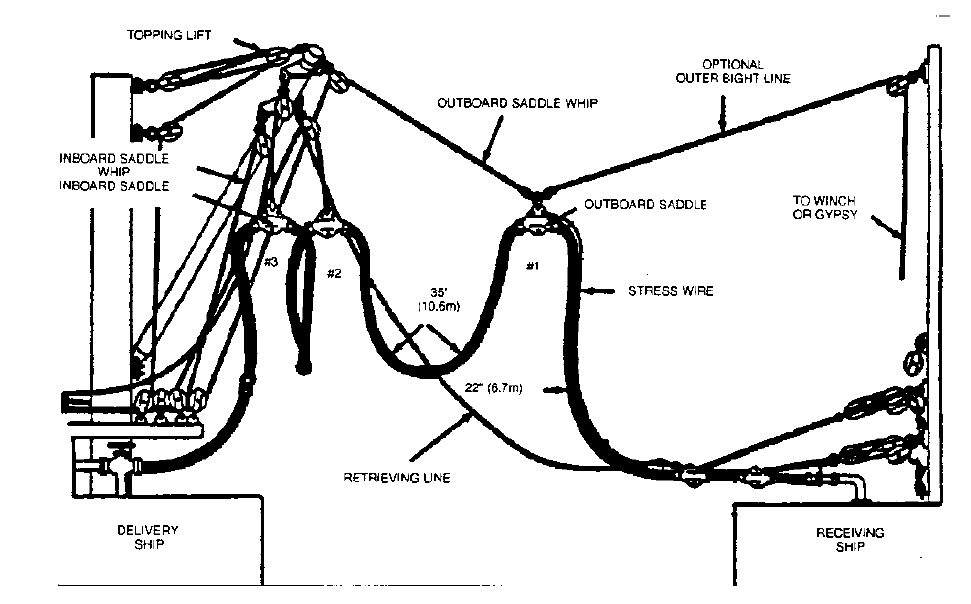
Diagrams of modern STREAM UNREP gear (top) and WWII-era close-in rig (bottom)
Once everything is hooked up, the two ships and their crews have to maintain their separation while the fuel flows. Modern equipment allows up to 180,000 gallons per hour to be pumped through each hose, although the situation in WWII was somewhat worse.11 At one point during WWII, the oiler Platte steamed next to Enterprise for 5.5 hours at night, separated by only 50'.
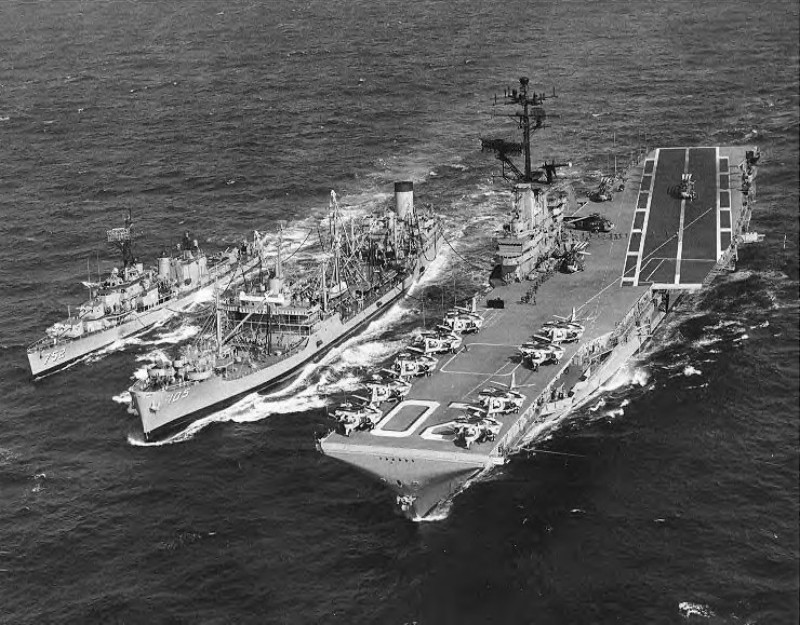
USS Mispillion refueling USS Bennington
When replenishment is completed, the hose is hauled back aboard the oiler, and then the spanwire is cast loose by the receiving ship. At this point, USN ships traditionally play breakaway music, a song that usually has some relation to the ship. Famous examples include the use of the Star Trek theme by the USS Enterprise and the William Tell Overture by Ranger. For ships without such an obvious connection, the song is chosen by the Captain.12
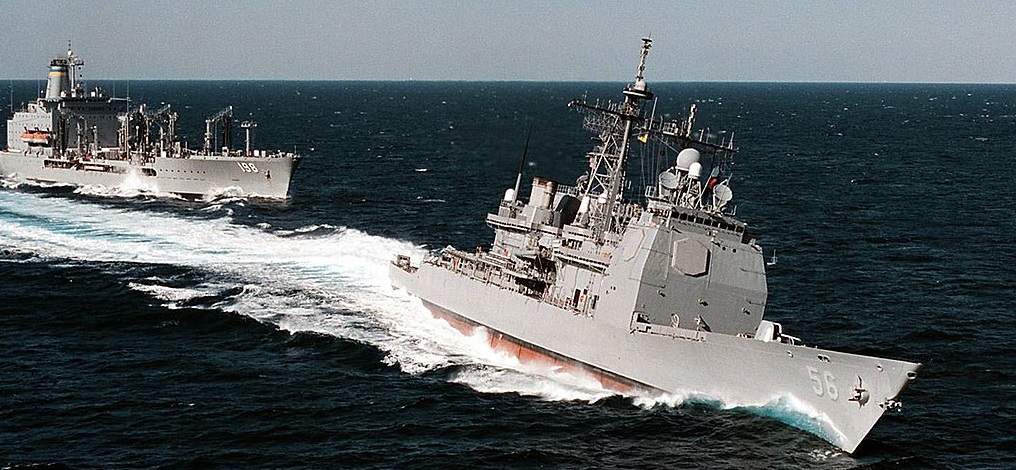
USS San Jacinto performs an emergency breakaway from oiler Big Horn
If things go smoothly, the breakaway is the easiest part of the UNREP, as the receiving ship merely has to steer away and increase speed slightly. If they don't, an emergency breakaway may be called for. That involves trying to get the ships as far apart as possible, which is somewhat more exciting.
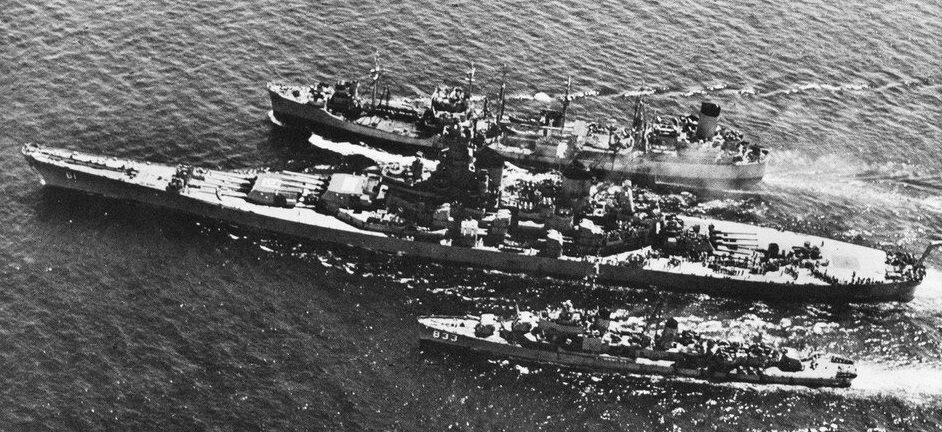
Iowa, a destroyer and an oiler off Korea
But despite all the development work, oilers alone weren't enough to support a war against Japan. Forward bases would be needed, and to make them mobile, most of the facilities had to be aboard ships. And to keep the fleet at sea even longer, the last year of the war saw the USN develop techniques to transfer ammunition and supplies at sea as well.
1 The various transfer equipment required so much power that the speed of the oiler was reduced to about 6 kts. ⇑
2 Later on, astern refueling was used fairly extensively during WWII. It was the primary method used for the Japanese heavy ships, although they had the ship being refueled in front. The British fitted their tankers for both alongside and astern refueling, and both methods were used to pass fuel from merchant tankers to destroyers escorting the Atlantic convoys. ⇑
3 It appears that an early report predicting serious problems with alongside fueling of larger vessels was taken as gospel. No trials were made, and Nimitz was the first to even think seriously of refueling cruisers and carriers from alongside oilers. ⇑
4 Four of these vessels were converted into the Sangamon class escort carriers early in the war to help plug the gap in the American carrier force. ⇑
5 This was standard in all of the big prewar auxiliaries. The tankers were expected to contribute to the AA defense of convoys, while the guns on the tenders would provide AA fire at the advanced base. ⇑
6 The kingposts that supported the hoses on Neches were probably too small to support the length of hose required in rough seas. ⇑
7 Samuel Eliot Morison blamed Frank Jack Fletcher, commander of the task force, for the slow fueling. It's not true, and it's quite possible that the force would have been destroyed had they been able to fuel quickly. I'm a huge Morison fan, but for some reason he hated Fletcher and never passed up a chance to take a stab at him. ⇑
8 Often known by the abbreviation UNREP. ⇑
9 The following description is based primarily on modern sources, and there were detail differences in WWII procedure. ⇑
10 Using radio could disclose their position to the enemy. ⇑
11 I don't have good numbers for this, sadly. ⇑
12 I'm not totally sure when this started. I believe it post-dates WWII, but Jim Pobog told me that off Vietnam, the oiler used to play the song. In the first part of their tour, under Captain Harold Baker, Mispillion played the song Harold's Super Service. When he was replaced and they were ordered home, they used Joni Mitchell's California instead. I don't know when it became traditional for the receiving ship to play the song instead. ⇑

Comments
Why would Iowa be in the center? Wouldn't it make more sense for the oiler to be in the center?
Also, did subs ever do UNREP?
I believe the destroyer was just an escort, not UNREPing during that shot. Iowa did have the equipment to UNREP destroyers, and did so frequently, but the kingpost for that is to starboard, not port. There might be some sort of highline transfer going on, but the picture isn't good enough to tell.
I don't know of them doing traditional UNREP. The Germans did refuel submarines from other submarines at sea (discussed in an upcoming post), but I don't know the exact mechanism used.
The parallels between this and mid-air refuelling are interesting.
Also, did you ever define UNREP? Is it Underway REPlenishment?
Apparently, I didn't. I'll have to fix that.
You mention that the carriers could burn 10% of their fuel in a day, which is obviously worrying, but what was the situation with regard to the rest of their stores, particularly av-gas?
Also, how do these numbers compare to modern carrier groups? Obviously the CVNs don't need fuel, but their escorts do, and they need JP8, etc.
It's complicated. During the war, a carrier usually had fuel and supplies for only a single-digit number of alpha strikes. However, the fuel use of the carrier might not correlate that well with the fuel use of the air group. Even if you're just flying off scouts and a light CAP/ASW patrol, you still need to turn into the wind, go to full speed, launch and/or recover your airplanes, then run at high speed to catch up to the rest of the fleet. Repeat every few hours. That uses a lot of fuel for the carrier, even if you're only running two dozen sorties a day. Particularly in the pre-war days, I suspect fuel oil may have been a bigger issue. But they soon found a way to tank avgas as well.
I know that thirsty escorts are a problem, but I don't have firm numbers to put on it. Sorry. I may do some poking around, but I can't make any promises.
I first saw the phrase "the Fleet Problems" and thought it was a time when the fleet had a lot of problems, sort of like The Troubles.
Naval war games would be another good topic for a post, or probably a series.
In general, the virtuous cycle whereby the interwar USN fused concepts developed in tabletop wargames at the NWC with operational testing via the Fleet Problems and the acquisition of new ships and weapons is an interesting topic that doesn't get as much attention as it should.
With regards to the Fleet Problems themselves, Al Nofi wrote a pretty good book about them called To Train the Fleet for War: The US Navy Fleet Problems. One of the really striking things is how open and self-critical the post-exercise group discussions were.
I think it would be worth having a slightly smaller fleet if we could get back to that mindset of strenuously testing our skills, CONOPS, and doctrine in realistic at-sea exercises. It would also be nice if wargames were taken more seriously instead of being fobbed off on very junior officers as make-work.
It's a topic that I'd like to write about if I had the time and knowledge. Unfortunately, I have a bunch of other stuff I've committed to (either publicly or to myself) and I don't know nearly as much about the interwar US Navy as I'd like. There's a couple of books on the subject on my Amazon list, but it's not going to happen soon.
@Directrix Gazer
I've heard lots of good things about the interwar fleet problems, and I'm in agreement that pushing for more of that sort of thing would be good. That said, part of the issue is the increased visibility of the Navy. Look at all the fallout from Millennium Challenge, and the increasing complexity of warfare means that you need to raise the simulation bar.
That looks like a very interesting book, but it's a lot more than I'm willing to pay for a book on that topic right now. I'll throw it on the Amazon list and hope the price comes down.
I thought the US Navy hates JP8 and won't anything fueled with it below deck.
Good catch. (They use a different fuel, JP-5, which has a higher flash point, but is otherwise pretty similar. The Navy tends to be more nervous about fire safety than the Air Force. Running away isn't an option.)
When I was on the USNS Sirius (T-AFS 8), we did a sort of very awkward UNREP with a Los Angeles-class sub, using boats. Subs sit too low in the water to use STREAM rigs with them, though I suppose VERTREP might be possible. I'm not sure why we didn't try that - we had a pair of MH-60S on board.
Regarding modern carrier groups - I'd be really curious just how fuel-hungry a group based on a Kitty Hawk would have been. I know there were quite a few auxiliaries deployed with the Connie CVBG when I was out there with them (2003ish) - a few Kaisers, a Sacramento, Sirius and another RFA ship, and we were headed back to port every few days to take on dry cargo, mostly food and repair parts. I can't imagine the oilers were much less busy.
I can look through US Carriers when I get home and see if Friedman has anything to say about fuel consumption.
And that's an interesting story about the SSN. I'd guess they didn't vertrep because there isn't a good place to drop the loads on a submarine, unlike a normal ship with a flight deck.